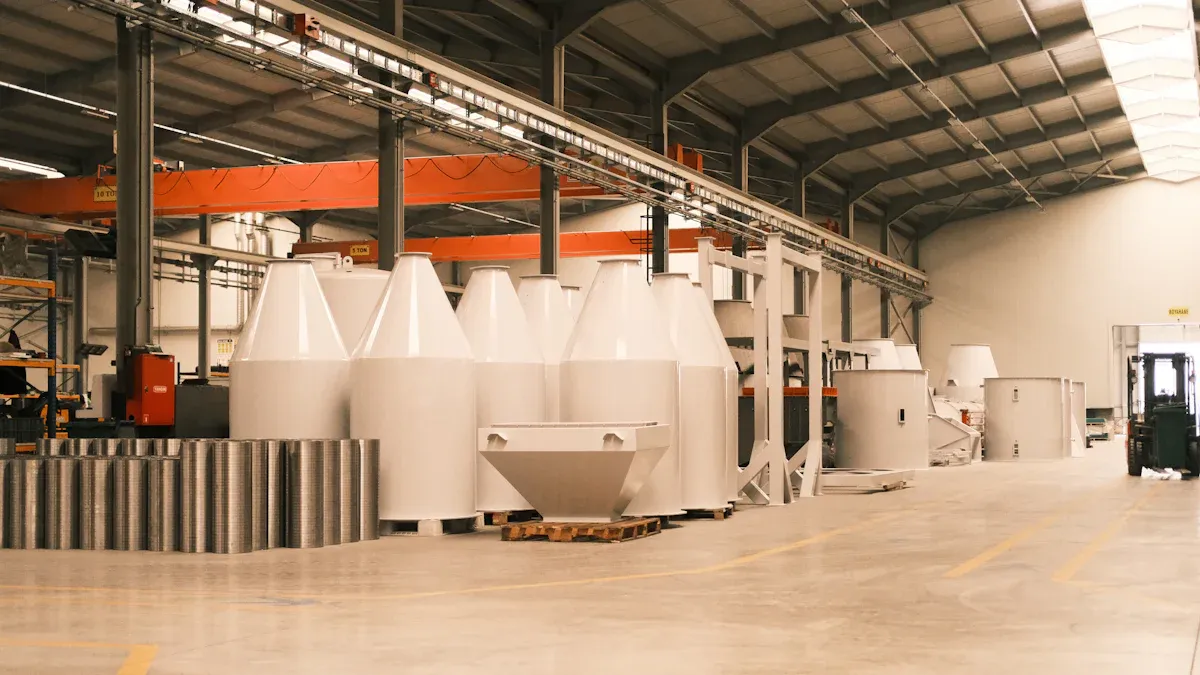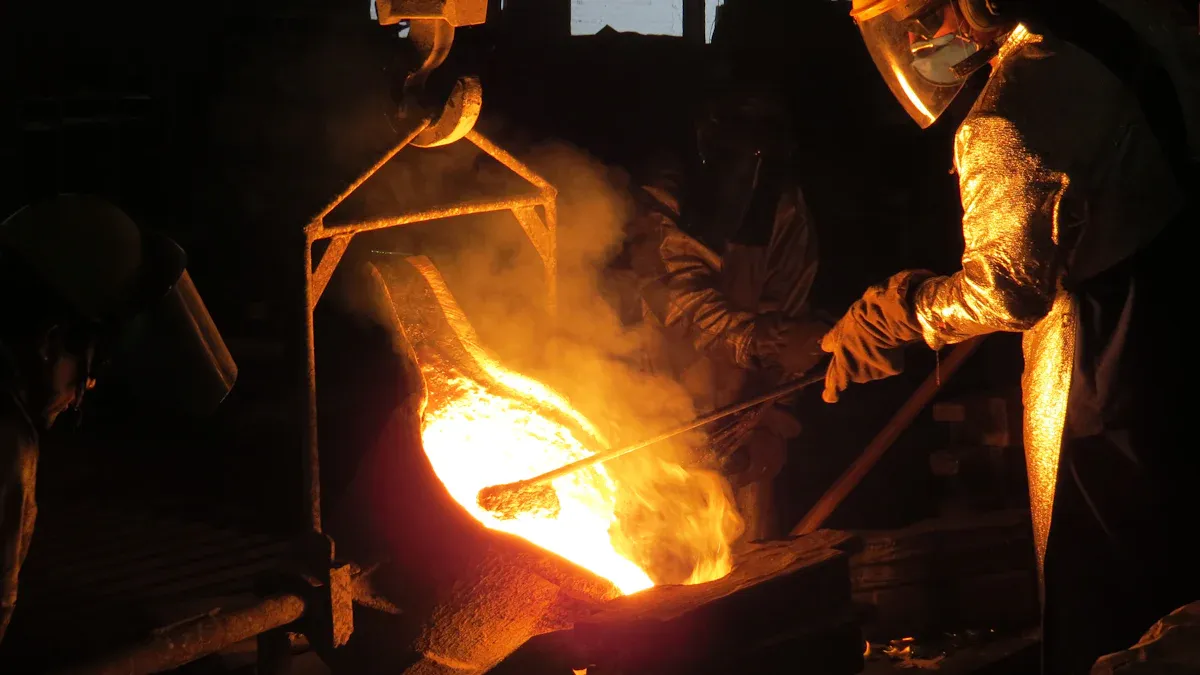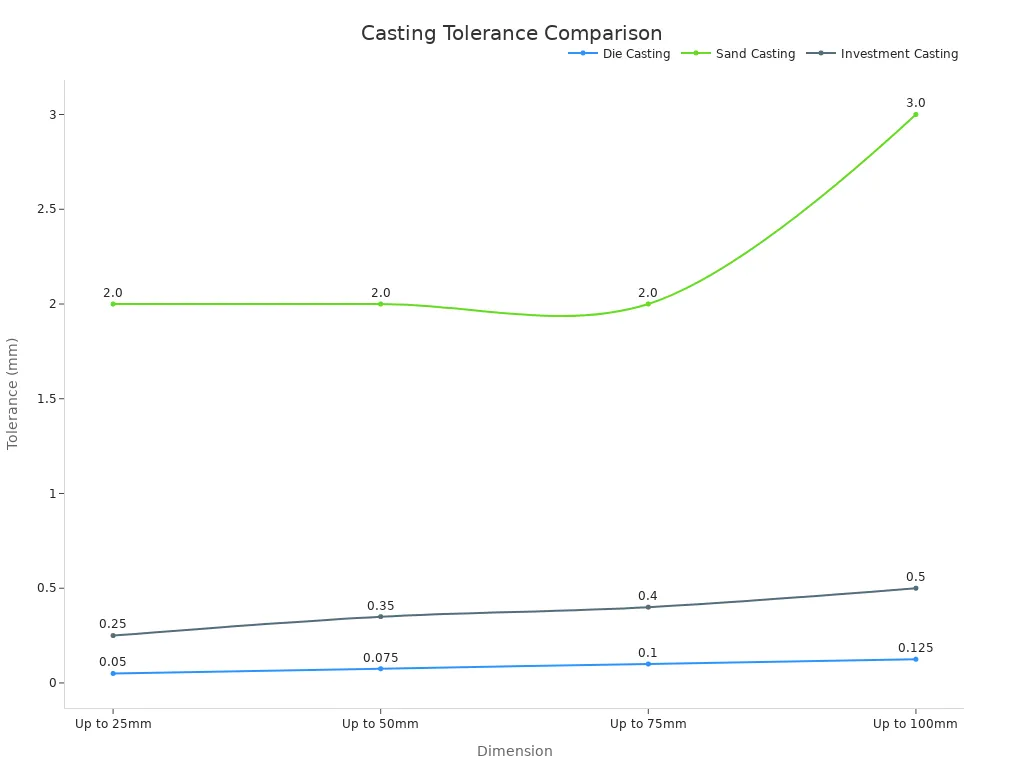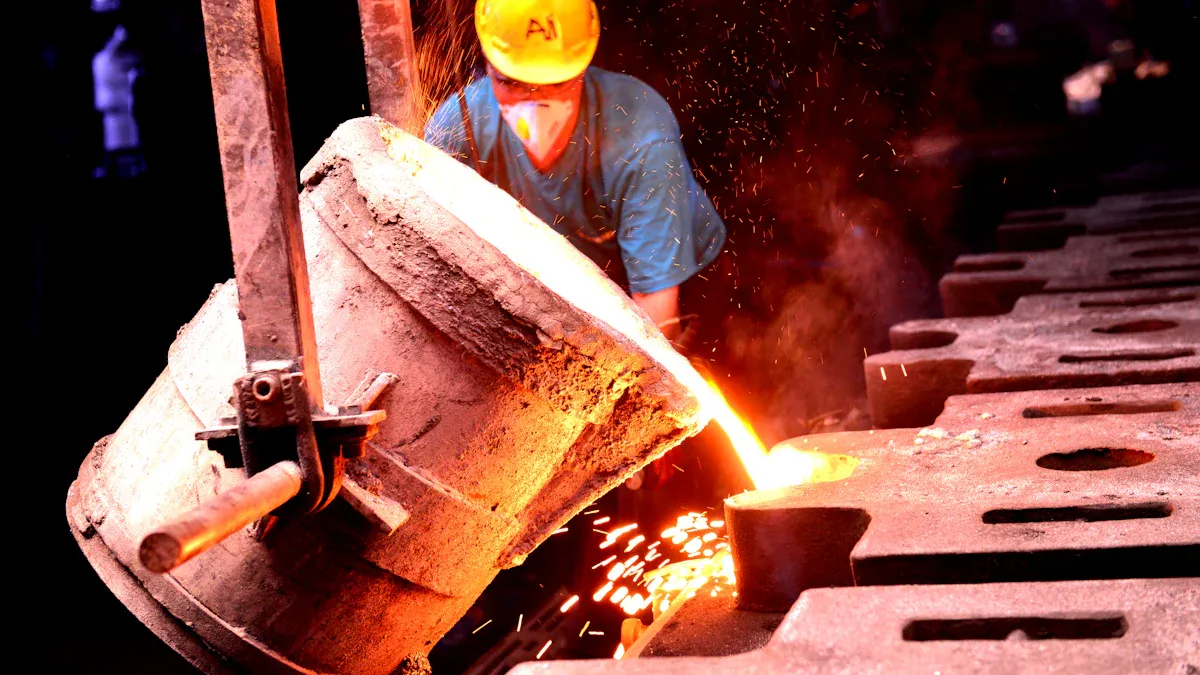How to evaluate the advantages of lost wax precision castings in instrument production

Lost wax precision castings used in instrumentation provide unparalleled precision and reliability. They produce components with outstanding surface finishes and intricate shapes. These characteristics make lost wax precision casting used in instrumentationperfect for manufacturing parts for medical devices, scientific tools, and industrial sensors. Its capability to manage complex designs guarantees high-quality outcomes for demanding applications, showcasing the importance of Precision Castings used in instrumentation.
Key Takeaways
- Lost Wax Casting givesgreat accuracy and smooth surfaces. It works well for detailed parts in medical and science tools.
- This process saves money for small batches. Reusable molds and less cutting help the environment.
- Lost wax casting makes tricky designs with exact sizes. It ensures top quality for tough jobs like in airplanes.
Overview of Lost Wax Casting

The Process and Key Features
Lost wax casting, also known as investment casting, is a time-tested method for creating precise and intricate components. The process begins with crafting a wax model of the desired part. This model is then coated with a ceramic shell, which hardens to form a mold. Once the wax is melted away, molten metal is poured into the mold to create the final product.
This method stands out for its ability to produce complex geometries with exceptional accuracy. It also minimizes material waste by reusing wax and molds, making it a sustainable choice. Industries like aerospace and automotive rely on this process for its consistency and ability to integrate with modern technologies like 3D printing. The table below highlights some key features:
| Feature | Description |
|---|---|
| Precision and Accuracy | Capable of producing intricate shapes and designs with high precision, ideal for critical applications. |
| Material Efficiency | The process allows for the reuse of wax and silicone molds, reducing costs and enhancing sustainability. |
| Consistency | Produces high-quality parts with minimal variation, crucial for industries like aerospace and automotive. |
| Integration with 3D Printing | Enables rapid design changes and significant lead time savings compared to traditional methods. |
Lost Wax Precision Castings Used in Instrumentation
Lost wax precision castings used in instrumentation are highly valued for their precision and reliability. They enable manufacturers to create components with tight tolerances and smooth finishes, which are essential for scientific and medical instruments. This process ensures that even the most intricate designs meet the exacting standards of these industries.
Practical Example: Precision Components for Medical Devices
Medical devices often require small, intricate parts that must function flawlessly. For example, surgical tools and implantable devices benefit from the precision of lost wax casting. This method ensures that each component meets strict quality standards, enhancing the safety and effectiveness of medical procedures.
Comparison with Other Casting Methods
Lost Wax Casting vs. Sand Casting
Lost wax casting and sand casting are two popular methods for creating metal components, but they cater to different needs. Sand casting is often chosen for its simplicity and low cost, especially for large parts or prototypes. However, it falls short when precision and surface finish are critical. Lost wax casting, on the other hand, excels in producing intricate designs with tight tolerances and smooth surfaces.
For example, in terms of precision, lost wax casting achieves tolerances as fine as ±0.1mm, while sand casting typically results in larger tolerances and rougher finishes. This makes lost wax casting ideal for applications like scientific instruments, where accuracy is paramount. The table below highlights some key differences:
| Feature | Investment Casting | Sand Casting |
|---|---|---|
| Precision | ±0.1mm, smooth surface | Larger tolerances, rougher finish |
| Surface Finish | Excellent | Moderate to poor |
| Cost | Medium to high | Low |
When it comes to instrumentation, lost wax precision castings used in instrumentation provide the level of detail and reliability that sand casting cannot match. This makes them a preferred choice for producing components like industrial sensors and medical device parts.
Lost Wax Casting vs. Die Casting
Die casting is another alternative to lost wax casting, particularly for high-volume production. It uses high-pressure molds to create parts quickly and efficiently. While die casting offers excellent dimensional accuracy and a smooth surface finish, it has limitations in terms of material compatibility and upfront costs.
Lost wax casting, by contrast, is more versatile. It supports a wider range of materials, including specialized alloys used in aerospace and medical instruments. Additionally, it is more cost-effective for small to medium production runs, as die casting requires expensive molds and equipment. The following table compares these two methods:
| Casting Process | Die Cost | Equipment Cost | Labor Cost | Production Rate (pieces/hour) |
|---|---|---|---|---|
| Sand Casting | Low | Low | Low – Medium | < 20 |
| Die Casting | High | High | Low – Medium | < 200 |
| Investment Casting | Medium-High | Low – Medium | High | < 1000 |
For scientific instruments, where small batch production and material flexibility are often required, lost wax casting proves to be a better fit. It balances cost and quality, making it a practical choice for intricate designs.
Practical Example: Surface Finish in Scientific Instrument Components
Surface finish plays a crucial role in the performance of scientific instruments. A smoother surface reduces friction, improves durability, and enhances the overall functionality of components. Lost wax casting consistently delivers superior surface finishes compared to sand casting, which often leaves a rough texture.
Take, for instance, the production of optical instrument housings. These components demand a flawless finish to ensure proper alignment and functionality. Lost wax casting achieves this level of precision, while sand casting would require additional machining to meet the same standards. The chart below illustrates the differences in casting tolerances across various dimensions:

By choosing lost wax casting, manufacturers can save time and resources while achieving the high-quality results required for scientific applications.
Key Points Summary:
- Lost wax casting offers superior precision and surface finish compared to sand casting, making it ideal for intricate designs.
- While die casting is efficient for high-volume production, lost wax casting provides better material flexibility and cost-effectiveness for smaller batches.
- For scientific instruments, lost wax casting ensures the smooth surface finishes and tight tolerances necessary for optimal performance.
Key Advantages of Lost Wax Casting

Dimensional Accuracy and Tolerances
Lost wax casting is renowned for its ability to achieve exceptional dimensional accuracy and tight tolerances. This makes it a go-to method for producing precision components in industries like medical, aerospace, and instrumentation. The process ensures that even the most intricate designs meet exact specifications, reducing the need for additional machining or adjustments.
For instance, the Replicast® process, developed by Casting Technology International Ltd., demonstrates how lost wax casting excels in precision. It achieves high standards of integrity for complex components like impellers, which are critical for pump operations. The table below highlights some of its key features:
| Feature | Description |
|---|---|
| Process Name | Replicast® process developed by Casting Technology International Ltd. |
| Dimensional Accuracy | Achieves high standards of integrity and precision for complex components like impellers. |
| Surface Finish | Superior surface finish compared to traditional methods. |
| Efficiency | Pumps using Replicast impellers are 10% more efficient than those made by traditional methods. |
| Production Cost | 30% lower production cost compared to other casting methods. |
| Pattern Material | Uses polystyrene patterns instead of wax, allowing for larger and heavier castings. |
| Application | Suitable for producing impellers with narrow passageways critical to pump operation. |
This level of precision ensures that lost wax precision castings used in instrumentation consistently deliver reliable and high-performing components.
Superior Surface Finish
A smooth surface finish is essential for many applications, especially in scientific and medical instruments. Lost wax casting naturally produces components with superior surface finishes compared to other methods like sand casting. This eliminates the need for extensive post-processing, saving both time and resources.
For example, in optical instruments, a flawless surface finish ensures proper alignment and functionality. Lost wax casting achieves this level of quality effortlessly. The process minimizes surface imperfections, resulting in components that are not only visually appealing but also highly functional.
Design Flexibility for Complex Shapes
One of the standout advantages of lost wax casting is its incredible design flexibility. This process allows manufacturers to create intricate shapes and complex geometries that would be impossible with other casting methods. It supports the production of parts with thin walls, seamless joints, and complicated inner profiles.
Here are some key benefits of its design flexibility:
- Enables the creation of intricate designs with high precision.
- Allows for the production of parts with very thin walls and complicated inner profiles without seams or joints.
- Widely used in industries like aerospace and medical fields, showcasing its versatility.
This flexibility makes lost wax casting an ideal choice for producing components with unique and challenging designs.
Practical Example: Intricate Parts for Industrial Sensors
Industrial sensors often require small, detailed components that must perform flawlessly under demanding conditions. Lost wax casting is perfect for manufacturing these intricate parts. Its ability to produce components with tight tolerances and smooth finishes ensures that sensors operate with high accuracy and reliability.
For instance, consider a sensor used in a high-temperature industrial environment. The sensor's housing must withstand extreme conditions while maintaining its structural integrity. Lost wax casting allows manufacturers to use specialized alloys and create complex designs that meet these requirements. This ensures the sensor performs optimally, even in the harshest environments.
Key Points Summary:
- Lost wax casting delivers exceptional dimensional accuracy and tight tolerances, reducing the need for post-processing.
- It produces superior surface finishes, enhancing the functionality and appearance of components.
- The process offers unmatched design flexibility, enabling the creation of intricate and complex shapes.
- It is ideal for manufacturing detailed parts for industrial sensors and other precision instruments.
Practical Considerations for Choosing Lost Wax Casting
Cost-Effectiveness for Small Batch Production
Lost wax casting shines when it comes to small batch production. It offers a cost-effective solution by reducing material waste and minimizing machining requirements. Manufacturers can reuse wax molds, which lowers production costs and supports sustainability. This process also delivers precise components, cutting down on finishing work and saving time.
For industries like aerospace and automotive, where precision is non-negotiable, lost wax casting provides a clear advantage. It allows for rapid design changes without the need for expensive tooling, making it ideal for prototyping or limited runs. The table below highlights some cost-saving aspects:
| Aspect | Details |
|---|---|
| Material Efficiency | Wax molds are reusable, reducing costs per part and enhancing sustainability. |
| Cost Reduction | Precision reduces finishing and machining times, lowering overall production costs. |
| Sustainability | Efficient material use and reusable molds contribute to eco-friendly production processes. |
Material Compatibility with Specialized Alloys
Lost wax casting supports a wide range of materials, including specialized alloys. This versatility makes it a preferred choice for applications requiring high-performance metals. Industries like aerospace rely on this process to produce components that withstand extreme conditions, such as turbine blades or sensor housings.
The process achieves tight tolerances and smooth finishes, even with challenging materials. For example, dimensional tolerances of ±0.003 inches per inch and surface finishes better than 125 RMS are achievable. These qualities ensure that parts meet strict performance standards without extensive post-processing.
When to Choose Lost Wax Casting Over Other Methods
Choosing lost wax casting depends on the complexity of the design and the production volume. It excels in creating intricate geometries with thin walls and seamless joints. If a project demands high precision, smooth surfaces, and reduced machining, this method is the way to go.
Here’s why manufacturers opt for lost wax casting:
- High Precision: Achieves tight tolerances and detailed geometries.
- Versatility: Works with various metals and alloys.
- Smooth Surface Finish: Reduces the need for extensive machining.
- Design Flexibility: Allows for complex designs tailored to specific needs.
For small to medium production runs, lost wax casting offers significant lead time savings and design freedom compared to traditional methods.
Practical Example: High-Performance Alloys for Aerospace Instruments
Aerospace instruments demand components that perform under extreme conditions. Lost wax casting enables the use of high-performance alloys like Inconel and titanium, which are essential for durability and heat resistance. For instance, turbine blades require precise dimensions and smooth finishes to optimize airflow and efficiency.
This process also supports intricate designs, such as narrow passageways in sensor housings. By using lost wax casting, manufacturers can produce reliable parts that meet stringent aerospace standards. The ability to combine material compatibility with design flexibility makes it a top choice for critical applications.
Key Points Summary:
- Lost wax casting is cost-effective for small batch production, thanks to reusable molds and reduced machining needs.
- It supports specialized alloys, ensuring compatibility with high-performance materials.
- Manufacturers should choose this method for projects requiring precision, smooth finishes, and complex designs.
- Aerospace applications benefit from its ability to produce durable, intricate components with tight tolerances.
Lost wax precision castings used in instrumentation offer unmatched precision, smooth finishes, and the ability to create intricate designs. These qualities make them ideal for high-precision components.
The process produces high-quality patterns with minimal machining. Mold cavities replicate dimensions to within several thousandths of an inch, ensuring exceptional dimensional quality and surface finish.
When choosing a casting method, consider production volume, material needs, and design complexity to decide if this process fits your project.
FAQ
What makes lost wax casting better for intricate designs?
Lost wax casting excels at creating complex shapes with thin walls and seamless joints. Its precision ensures even the most detailed designs meet exact specifications.
Can lost wax casting handle high-performance materials?
Yes! Lost wax casting supports specialized alloys like titanium and Inconel. These materials are perfect for aerospace, medical, and industrial applications requiring durability and heat resistance.
Is lost wax casting cost-effective for small production runs?
Absolutely! It minimizes material waste and reduces machining needs. Reusable molds also lower costs, making it ideal for prototyping or limited batch production.















